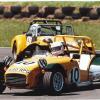I’ve been wondering why the cycle winged or separate winged sports car died out when it did.
Prewar, sports cars generally had separate wings and in some cases running boards as well. For competition cars these wings were often reduced to the bare minimum, ie cycle wings. This allowed many cars to be dual purpose – remove the wings and you have a racing car. Then Bugatti came along with the T57 ‘tank’ and the Adler coupé which totally integrated the wings into the body. Several cars had the wings progressively integrated into the front bodywork: the BMW 328, postwar T-Series MGs and Jaguar XK120 represent a halfway house where the wings were integrated but still visually separate. Then the Ferrari Barchetta, Jaguar C-Type, MGA etc had fully integrated front wings.
But some makers continued to produce cycle-winged cars. The 1950 Le Mans winning Talbot and the Le Mans Replica Frazer Nash come to mind. Possibly because the idea of the dual purpose car was still current. Or maybe the body was lighter and because of the smaller frontal area the aerodynamic disadvantage was not as great as it appears at first glance.
Then overnight they all vanished. By 1956 about the only sports cars with separate mudguards were the Lotus Mk 6 and the Morgan.
Can anyone suggest why the final change was so rapid? Previously it had been a slow evolution then suddenly the rate of change speeded up.
I believe that at some stage the CSI banned separate cycle wings and required them to be integral with the bodywork. When? And why did they decide to do so?
















